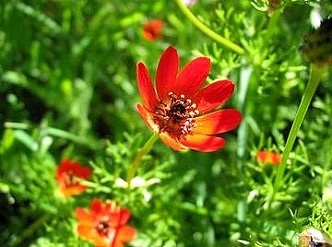Contents:
Common Names | Parts Usually Used | Plant(s) & Culture | Where Found | Medicinal Properties
Legends, Myths and Stories | Uses | Formulas or Dosages | Bibliography
Scientific Names

- Hepatica triloba L.
- Hepatica Americana L.
- Ranunculaceae
- Buttercup family
Common Names
- Choisy
- Kidney liver leaf
- Lichen caninus
- Liverleaf
- Liverwort
- Round-lobed hepatica
Parts Usually Used
Leaves, flowers
Back to Top
Description of Plant(s) and
Culture
Hepatica is a small perennial plant; the much-branched rootstock produces a rosette of rounded 3-lobed, long-petioled, leathery evergreen leaves which are green on top and reddish-purple beneath. The leaves last through the winter and are maroon all winter, the new leaves appearing after the plant flowers. The light blue, sometimes reddish-blue or white flowers grow on hairy scapes from March to early June.
Blooms appear before the semi-evergreen leaves become lush. The genus name Hepatica refers to the liverlike shape of the leaves. The leaves are traditionally used for liver ailments as the name implies.
Another variety: Sharp-lobed hepatica or Heart liverleaf (H. acutiloba) is similar to round-leaved hepatica, except that its leaves have pointed lobes and that it flowers (bluish-lavender or pinkish, though often whitish) in February to early June. Six to ten “petals” are actually sepals. Found in rich woods. Western Maine to Georgia; Louisiana, Arkansas, Missouri to Minnesota. Medicinally, both plants are equivalent.
Back to Top
Where Found
Grows in woodlands of the eastern United States, westward to Iowa and Missouri, and in Canada and Europe.
Found in warm, moist tropical conditions, along stream banks and in damp shaded forests (some occur in drier situations) from Nova Scotia to Georgia; Alabama, Missouri to Manitoba.
Back to Top
Medicinal Properties
Diuretic, pectoral, mild mucilaginous, deobstruent, demulcent, tonic, astringent
Back to Top
Legends, Myths and Stories
Hepatica is one of our earliest harbingers of spring. The liverworts or hepatica include some 8,500 species in approximately 237 genera. Most of them are small, leafy plants, easily and commonly mistaken for mosses.
Back to Top
Uses
The tea is used for chronic bronchitis, coughs, fever, colds, sore throat, jaundice, bleeding of the lungs and early symptoms of consumption, liver congestion, indigestion, headache, gallbladder problems, and kidney ailments. Used to stop gastric hemorrhage and vomiting of blood. The fresh plant is irritating to the skin and should not be used on wounds.
Back to Top
Formulas or Dosages
Cold extract: use 2 tsp. fresh leaves or 4 tsp. dried leaves and flowers with 1 cup cold water. Let stand for 8 hours and strain. Take 1 cup per day.
Tincture: add a handful of the dried herb to 1/2 to 3/4 qt. whiskey. Let stand at room temperature for about 3 weeks, then strain. Take 10-15 drops on a sugar cube, 3 times a day, for liver, gallbladder, and kidney problems.
Back to Top
Bibliography
![]() Eastern/Central Medicinal Plants
Eastern/Central Medicinal Plants, by Steven Foster and James A. Duke., Houghton Mifflin Company, 215 Park Avenue South, New York, NY 10000
![]() The Herb Book
The Herb Book, by John Lust, Bantam Books, 666 Fifth Avenue, New York, NY. copyright 1974.
 How Indians Use Wild Plants for Food, Medicine & Crafts
How Indians Use Wild Plants for Food, Medicine & Crafts, by Frances Densmore, Dover Publications, Inc., 180 Varick Street, New York, NY 10014, first printed by the United States Government Printing Office, Washington, in 1928, this Dover edition 1974
![]() Indian Herbalogy of North America
Indian Herbalogy of North America, by Alma R. Hutchens, Shambala Publications, Inc., Horticultural Hall, 300 Massachusetts Avenue, Boston, Massachusetts 02115, 1973
![]() Webster’s New World Dictionary
Webster’s New World Dictionary, Third College Edition, Victoria Neufeldt, Editor in Chief, New World Dictionaries: A Division of Simon & Schuster, Inc., 15 Columbus Circle, New York, NY 10023
 The Rodale Herb Book: How to Use, Grow, and Buy Nature’s Miracle Plants (An Organic gardening and farming book)
The Rodale Herb Book: How to Use, Grow, and Buy Nature’s Miracle Plants (An Organic gardening and farming book), edited by William H. Hylton, Rodale Press, Inc. Emmaus, PA, 18049., 1974
